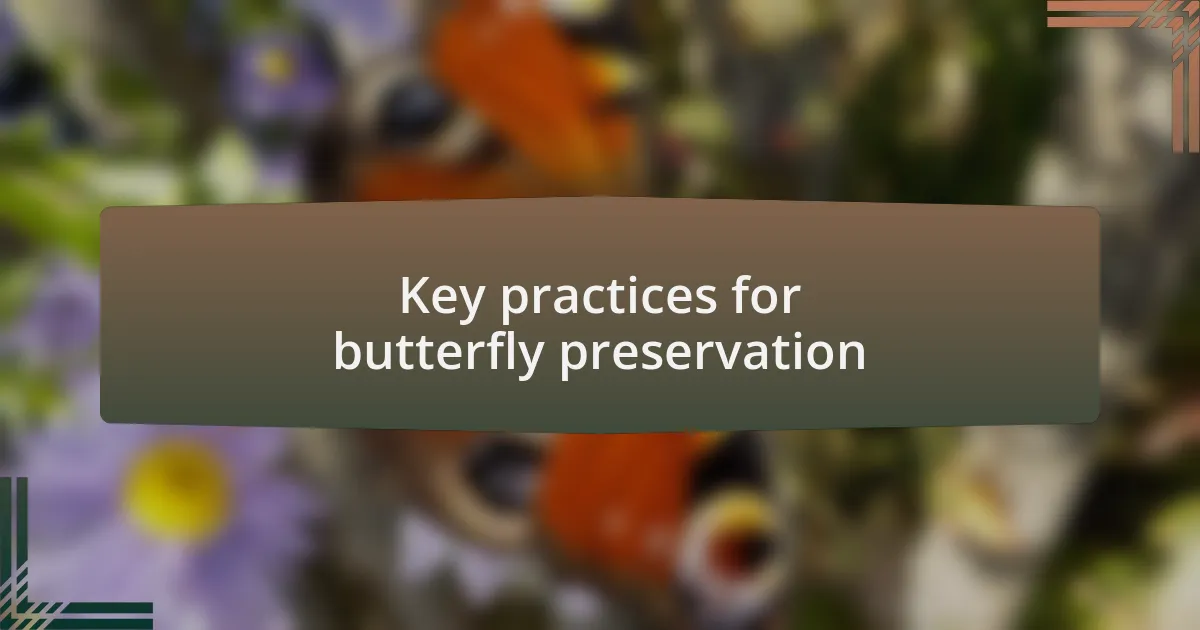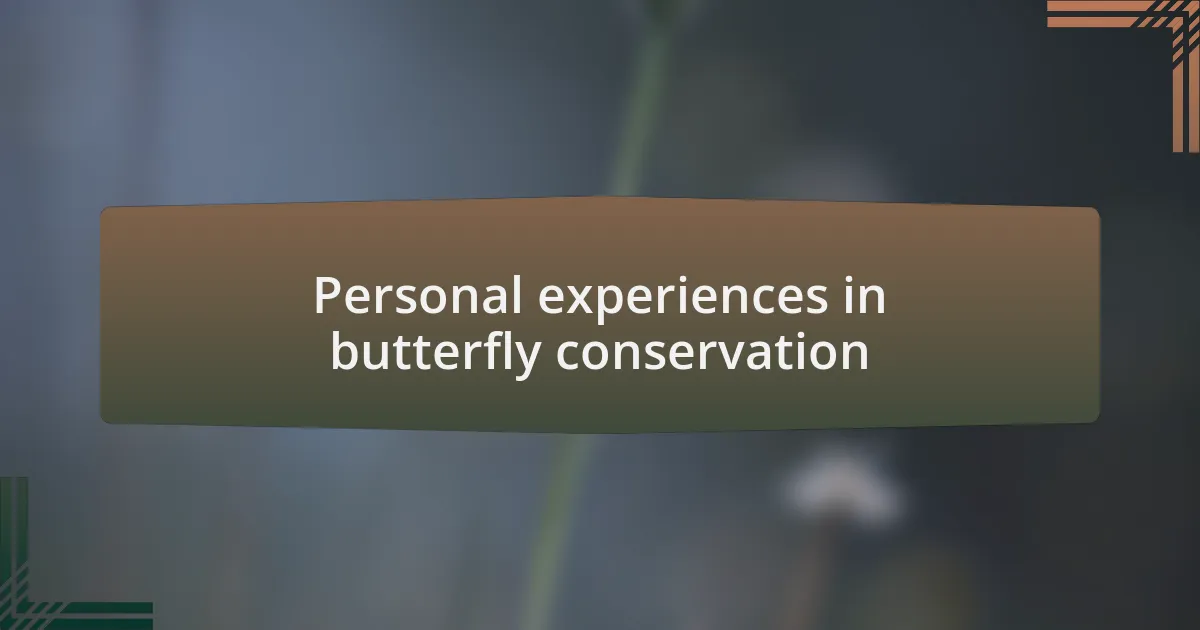Key takeaways:
- Butterflies are crucial indicators of ecosystem health and play a significant role in pollination, impacting biodiversity and food security.
- Creating butterfly-friendly habitats involves using native plants, reducing pesticide use, and promoting public awareness to encourage conservation efforts.
- Personal experiences in conservation highlight the joy and community spirit that come from collective efforts to protect butterfly populations and their habitats.
- Enhancing local habitats requires planting diverse native flowers, providing shelter, and using organic gardening practices to support pollinator health.

Understanding butterfly conservation importance
When I think about butterfly conservation, I can’t help but see these delicate creatures as indicators of our ecosystem’s health. Their presence not only enriches our gardens but symbolizes the intricate balance of nature. Have you ever paused to appreciate how a single butterfly can brighten your day and remind you of the beauty of biodiversity?
In my own garden, I’ve noticed how the more diverse the plants, the more butterflies I attract. It’s fascinating to observe them flitting from flower to flower, each one playing a role in pollination. But what if we lose these beautiful creatures? Without butterflies, many plants would fail to reproduce, leading to significant impacts on the food chain. It’s a vivid reminder of how interconnected we all are in this web of life.
Moreover, conserving butterflies goes beyond just protecting a species; it’s about preserving the very ecosystem services they provide. During my evening walks, I often reflect on how healthy butterfly populations contribute to our food security by helping to pollinate fruits and vegetables. Isn’t it amazing how a creature so small can have such a profound effect on what ends up on our plates?

Key practices for butterfly preservation
Creating habitats that nurture butterflies is one of the most impactful practices we can adopt. I recall transforming a small patch of my yard into a wildflower garden, filled with native plants. Over time, I was amazed to see how many butterflies visited, drawn to the vibrant colors and diverse shapes. It truly highlighted the importance of using native species, as they provide the food and shelter that butterflies rely on during their life cycles.
Another essential practice is reducing pesticide use in our gardens. I used to think that a perfectly manicured lawn was the goal, but then I learned how harmful chemicals can disrupt butterfly populations. After making the switch to organic methods, I noticed not only an uptick in butterflies but a richer overall ecosystem. It’s a small change that brought me great joy; have you ever felt that satisfaction in knowing you’re doing something good for nature?
Lastly, I’ve found that promoting public awareness is crucial. I often host small workshops in my community to share tips on butterfly-friendly gardening. Engaging others in conversation about these beautiful insects fosters a shared commitment to their preservation. Isn’t it rewarding to think that knowledge can ripple outward, encouraging more individuals to join the cause?

Creating a pollinator-friendly garden
Creating a pollinator-friendly garden starts with selecting the right plants. I recall visiting a friend’s home, where the garden was a riot of colorful blossoms — coneflowers, milkweed, and asters. The sight of bees and butterflies flitting from flower to flower was mesmerizing, and it made me realize how vital it is to choose native plants. Native flora not only thrives in local conditions but also provides the specific nourishment that these pollinators need.
In my own garden, I’ve embraced not just flowers but also the concept of continuity in bloom. I learned that planning for sequential blooming can keep visitors fed throughout the seasons. For instance, I placed early-blooming crocuses alongside late-summer sunflowers, creating a buffet for pollinators from spring to fall. Watching their return year after year, I’ve often wondered: how incredible is it to witness nature’s cycle right in your backyard?
I also discovered the importance of providing shelter. Initially, I thought a clean garden was the ideal, but then I started to include brush piles and small habitats. Now, when I see butterflies resting among the leaves or caterpillars munching on host plants, I feel like I’m actively participating in a larger story. Have you ever considered how a little mess can lead to a thriving ecosystem? It’s a lesson I cherish, and every fluttering visitor feels like a nod of appreciation for the effort taken to create their haven.

Personal experiences in butterfly conservation
One of my fondest memories in butterfly conservation is the day I decided to turn a neglected corner of my yard into a butterfly sanctuary. I vividly remember working diligently, planting flowers rich in nectar and designating space for butterfly host plants. As I sat back to admire my work, I spotted a Monarch caterpillar nestled among the milkweed leaves, and that moment filled me with a profound sense of joy and purpose. It made me realize how small efforts can lead to big changes in our ecosystems.
Another experience that stands out is when I volunteered at a local conservation event. I was surrounded by fellow enthusiasts, all eager to learn and share. We set up butterfly traps to collect data, and I felt a surge of excitement each time we released a butterfly, watching them flutter freely into the sky. It struck me how collective efforts can amplify our impact and inspire others. Have you ever experienced that rush of community spirit while working toward a common cause?
Lastly, I recall a peaceful afternoon spent observing butterflies basking in the sunlight near my newly built butterfly garden. One particularly vibrant Swallowtail landed right in front of me, and I was captivated by its beauty. In that quiet moment, I realized how crucial it is for us to protect these delicate creatures. It’s a reminder that preserving their habitats isn’t just about saving species; it’s about preserving the simple, joyful experiences they bring into our lives.

Tips for enhancing local habitats
Creating vibrant habitats for pollinators, like butterflies, starts with understanding their needs. For instance, I discovered that planting a variety of native flowers ensures a continuous nectar supply throughout the seasons. When I added plants that bloom at different times, I noticed an increase in butterfly visits, which made the garden feel alive and connected to nature. Have you ever watched a butterfly flit from flower to flower? It’s truly a mesmerizing sight that highlights the importance of diversity in our gardens.
Alongside blossoms, I’ve found that providing shelter is equally vital. I built simple structures with brush piles and logs, giving butterflies and other beneficial insects a safe place to rest and even hibernate. It might seem small, but the joy I felt when I noticed butterflies resting in these cozy spots was immense. Have you tried incorporating natural elements like these in your outdoor space? You may be surprised at how quickly your local wildlife responds.
Lastly, I learned the importance of reducing pesticide use. Initially, it was challenging to let go of certain products I thought were harmless, but switching to organic options made a significant difference in my garden’s health. I couldn’t believe how many more butterflies I saw once I adopted safer practices! It’s a rewarding journey, and I encourage you to contemplate how your choices can impact not just the butterflies, but the entire ecosystem. What changes will you make to support these essential pollinators?